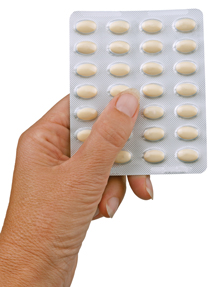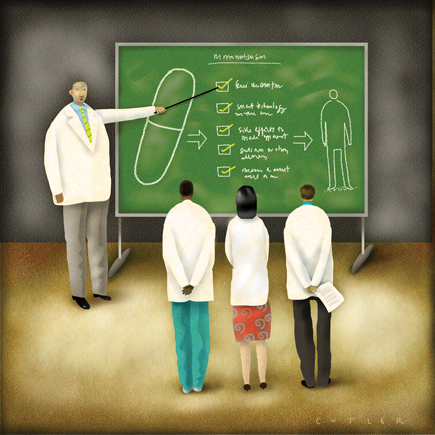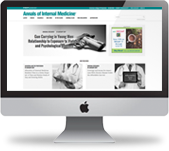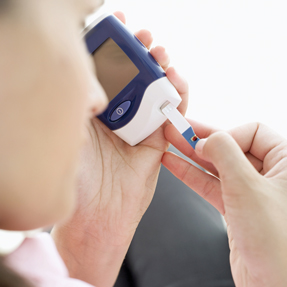Hormone therapy stirs debate 10 years after WHI
The Women's Health Initiative dramatically decreased hormone therapy for menopause, but 10 years later, the “knee-jerk” reaction has become more nuanced in how the regimen can be used.
Remember 2002? Internists used phones just for talking, wrote notes on paper, and prescribed hormone therapy to almost any older woman who would take it.
Then, the Women's Health Initiative (WHI) trial of hormone replacement therapy was halted when researchers found that the risks had exceeded the benefits. Women who were randomized to receive estrogen plus progestin had higher rates of stroke, venous thromboembolism, breast cancer and coronary heart disease than those on placebo.

Publication of the study results changed medical practice almost immediately.
“There was a knee-jerk reaction to the study,” said Virginia Miller, PhD, a researcher at the Mayo Clinic in Rochester, Minn. One recent analysis of a pharmacy claims database found that hormone prescribing had dropped by 30% by the end of 2002 and continued down from there.
“There was a tremendous rapid decrease in the first couple of years, and then a continuous decrease in the number of hormone therapy prescriptions. There has been an 80% or so reduction [from 2002 to today],” said endocrinologist Bruce Ettinger, MD, lead author of the claims analysis, which was published in Menopause in June.
But the decrease in prescribing hasn't been the only change in hormone therapy in the past decade. Physicians, researchers and women have been experimenting with alternative solutions to the problems of menopause, including non-oral hormone formulations, smaller doses and non-hormonal therapies.
Debate about the relevance of the WHI, in which the average patient was 63 years old, to subgroups of women, especially younger ones, has also been ongoing. To mark this decade of discussion and change, ACP Internist recently consulted experts in hormone therapy for their perspectives and advice.
Going down
In addition to the drop in overall hormone prescribing, recent data have shown a shift to lower-dose hormone therapy. According to Dr. Ettinger's analysis, in 2002, about 6% of hormone prescriptions were for doses under 0.625 mg of conjugated equine estrogens. By 2009, those formulations made up 25% of the claims.
The transition followed naturally from a shift in expert opinion.
“There are a lot of guidelines that say use the smallest dose for the shortest time,” said Dr. Ettinger, who is an emeritus clinical professor at the University of California, San Francisco.
However, there's not a lot of evidence to support those guidelines, other experts countered. “How they came up with that from the WHI, which studied one dose of estrogen compounds, don't ask me,” said Dr. Miller.
One of the lead investigators of the WHI, Jacques Rossouw, MD, agreed that evidence is lacking on whether lower doses affect the adverse outcomes that worry women most, cardiovascular disease and breast cancer. “There haven't been any large trials of a lower dose,” he said.
But, he added, there appear to be some other potential benefits.
“The lower dose works for osteoporosis [prevention]. It does also work for relieving vasomotor symptoms,” said Dr. Rossouw, who is chief of the WHI branch in the division of cardiovascular sciences at the National Heart, Lung, and Blood Institute.
Another change following but not directly supported by the WHI was a shift to non-oral formulations of hormone therapy. Dr. Ettinger's analysis found that prescription transdermal hormone therapies dropped only 25% between 2002 and 2009 compared to 77% for oral. “Whereas the orals have taken a huge hit, the transdermals have held up,” he said.
Another pharmacy claims analysis, published in the same issue of Menopause, found increasing use of another alternative: vaginal formulations. The prevalence of those prescriptions grew from 2.1% of women over age 50 in 2000 to 3.3% in 2009.
“There's lot of interest in non-oral forms,” said Amy Steinkellner, PharmD, lead author of the analysis and national practice leader for the Express Scripts (formerly Medco) Women's Health Therapeutic Resource Center. “There are a number of still ongoing studies looking at the long-term safety and benefits and risks of other formulations.”
Small studies of transdermal hormones have provided short-term data. “There's reasonably good evidence that transdermal estradiol does not have the increased risk of venous thrombosis,” said Dr. Rossouw. “It does have the same effect on breast cancer. But whether transdermal has a lower risk of coronary artery disease and stroke is not known. Theoretically it should.”
Vaginal estrogen holds potential to cause fewer systemic side effects because it's treating problems locally. “If a woman has only the urogenital symptoms—the vaginal dryness, dyspareunia—she can take the local vaginal estrogen alone,” said JoAnn E. Manson, MD, FACP, chief of preventive medicine at Brigham and Women's Hospital in Boston and a principal investigator of the WHI.
Some prescribers appear to agree. Dr. Steinkellner's analysis found that by 2006, the vaginal route was predominant among women initiating therapy. But those prescriptions may be coming from only a fraction of physicians, according to the experts. “Many women are being denied local, vaginal treatment with estrogen because some clinicians are not familiar with its use,” Dr. Manson said.
Reluctant prescribers
Lack of familiarity with all forms of hormone therapy may have caused a shift in prescribing found by both Menopause analyses. An increasing percentage of hormone prescriptions are coming from obstetricians/gynecologists rather than internists or family physicians.
“Many primary care clinicians may not be getting the training anymore, and because fewer patients are taking these medications, they are not getting the experience to be comfortable with the prescription of these medications and the different options,” said Dr. Manson.
OB-GYNs, on the other hand, are more likely to still receive training and information on hormones.
“They are closer to the science and they are more aware of the newer guidelines. They are committed to using hormone therapy but they are also committed to using it as safely as possible,” said Dr. Ettinger.
Perspectives on the safety of hormones might also vary between the specialties. OB-GYNs may hear more frequent patient complaints about menopause symptoms, while internists spend more time dealing with the cardiac problems and cancer risks found to be associated with hormone therapy.
“In the internal medicine community, the impetus for the WHI came out of cardiac disease prevention. [When that wasn't found], they pretty much closed the door on it,” said Margaret Polaneczky, MD, an associate professor of obstetrics and gynecology at Weill Medical College in New York. “There are a few doctors who, after the WHI, said, ‘No, you can't use hormone therapy.’ I know one doctor who said, ‘You can shoot yourself, but I'm not going to give you the gun.’”
But, she added, that response is rare enough that it can't explain the enormous drop in prescribing. “I think the difference is women. When you explain the benefits and risks, in what I think is a balanced way, most of them choose not to use it,” Dr. Polaneczky said.
Women's preferences may also be behind another trend that Dr. Steinkellner's analysis found. Hormone use dropped most in older women (who had the most adverse effects in WHI), but it didn't totally go away, despite official recommendations that hormones only be used in women with symptoms shortly after menopause. (How long is shortly? Within ten years, according to Dr. Rossouw.)
Higher-risk groups
“It's a bit perplexing why we still have so many women 65 and older who are still on hormone therapy,” Dr. Steinkellner said. Her study found that 7.4% of 65- to 75-year-olds were receiving prescriptions for hormones in 2009. “Some people theorize that those women were on hormone therapy at the time of the WHI results, were getting good response and didn't want to change,” she said.
Unfortunately, older women who are getting symptomatic benefit from hormone therapy may be the ones most likely to suffer negative effects, such as breast cancer and cardiovascular problems.
“About 10% of women continue to have symptoms [long term]. That's a tough thing, but this is just not a good therapy for them,” Dr. Rossouw said. “One thing everybody agrees on is ‘Don't give hormones to older women’ and I've added ‘Don't give it to older women with symptoms in particular.’”
Even if they weren't the ones to start it, internists should start the dialogue about stopping systemic hormone therapy with these older patients, according to Dr. Steinkellner.
“[Women over 65] are probably less inclined to be going to their OB-GYN on an annual basis, yet it's likely that the OB-GYN is the one who is renewing those prescriptions,” she said. “Be aware that patients may be on therapy because nobody's brought up the discussion with them.”
Older women who are reluctant to quit hormones may agree to trying lower doses or other formulations as a first step, she suggested.
Dr. Rossouw and other researchers have devoted much effort to identifying other patient subgroups that face higher risks from hormone therapy.
“Really the only thing we've come up with in many, many lab investigations is high blood cholesterol,” Dr. Rossouw said. “Women with an LDL cholesterol above 130 mg/dL are the women who are at increased risk of coronary artery disease [on hormone therapy].”
Women with high blood pressure or a family history of breast cancer might also be better off not treating their menopause symptoms with hormones, he added.
“For younger women with symptoms, it's fairly straightforward. If you ask some simple questions, do some simple tests, you can make decisions,” Dr. Rossouw said.
Explain and share
Most physicians will find, however, that this highly publicized issue is one on which many patients will want a share of the decision-making, the experts said.
“Very few ask me what I would do myself,” said Dr. Polaneczky. “Some of them come in having clipped out articles. Other ones come in with Suzanne Somers' book and they tend to be quite erroneously informed. I spend my time with that group giving them a reality check.”
With other patients, her time is spent explaining statistical data.
“I give them the numbers: If you use hormone therapy for 20 years, your breast cancer risk will be 1% higher, so if you're going to use it for two years, it's going to be a tenth of a percent. That feels too high for many women and you have to respect it,” Dr. Polaneczky said.
The data should also be explained in terms of absolute risk, Dr. Manson advised. “What is the likelihood per 1,000 women or 10,000 women per year?” she asked. (See sidebar for more on the absolute risk of hormones.)
Explaining the current understanding of hormone therapy can be time-consuming and tricky, the experts acknowledged.
“It's an art to be able to listen to the patient and present the incomplete data that we have in a fashion that the patient can get it,” said Dr. Ettinger. “I think part of the decrease in hormone therapy prescribing has to do with physicians not being willing to spend the time to explain the risks and benefits.”
Dr. Manson has found that patient decisions about hormone therapy will often be based on the severity of their symptoms. “Many women will say it's just so important that they not have these distressing symptoms that are interrupting their sleep, impairing their quality of life, causing them to be unable to function in their jobs, that they are willing to accept some of these small absolute risks,” Dr. Manson said.
For women who aren't so certain, a trial of therapy can be helpful. “If a patient is willing to try HRT, I may suggest that she give it a short trial for one to three months to see if her symptoms improve. At that point, she can choose to continue or not, depending on its impact on how she feels,” said Dr. Polaneczky.
Even in women who opt for hormones, therapy is often short-lived. “The vast majority of women who start hormone therapy are not taking it six months later,” said Dr. Ettinger. “Immediate side effects and concerns about long-term safety appear to offset the symptom benefit for many.”
A number of other solutions can be tried if a woman is not interested or not suited for hormone therapy.
“For a woman who has mild to moderate symptoms, start with lifestyle modifications: common-sense measures such as lowering thermostats, wearing layered clothing, avoiding triggers such as hot beverages, coffee, alcohol, spicy foods, smoking, emotional stress,” said Dr. Manson. “Some women will find exercise and weight loss to be of benefit, if they are overweight or obese.”
Other options are a bit more controversial. Antidepressants have helped women in some trials, but Dr. Ettinger is leery. “I'm more than a little concerned about SSRIs and the potential side effects on mood, appetite and behavior,” he said.
Expert opinions also differ when it comes to herbal remedies, which include black cohosh and soy extract. “There are a lot of patients in my practice over the years who have gotten relief from herbal remedies. I think very little harm is done by that,” said Dr. Ettinger.
Dr. Polaneczky takes a slightly different approach. “Any remedy has risks as well as benefits, whether it be HRT, SSRIs or herbal remedies,” she said. “Herbal remedies in particular should not get a free ride. For most, efficacy is limited. For those where there may be some efficacy, namely black cohosh and soy, the possibility of estrogen-like effects on the breast must be considered.”
None of the alternative therapies are a perfect panacea, noted Dr. Polaneczky. “Like HRT, I try to limit their use to the immediate peri-menopausal period in women who understand their risks as well as benefits.”
The future
Two trials of hormone therapy, KEEPS and ELITE, are expected to release results in the next year or so. (The KEEPS results will be presented at the North American Menopause Society meetings in October 2012.)
“I think many gynecologists are hoping there will be some good news coming out about this, but I'm rather pessimistic about a big change in the proportion of women who will be using hormone therapy,” said Dr. Ettinger.
Even Dr. Miller, a principal investigator on the KEEPS trial, managed expectations for its results. Study participants, who were women within three years of menopause, took low-dose oral or transdermal estrogen.
“The good news is we'll get answers [about safety and efficacy of] these formulations which are currently being used in clinical practice,” she said. “But is it going to answer questions that the WHI raised? No, because there were too many variables that were changed.”
The new studies are also looking at different outcomes from the WHI. KEEPS researchers are measuring coronary artery calcification and carotid artery intima-media thickness as markers for cardiovascular disease progression.
“So they won't be able to give us the definitive answer of whether lower dose has a lower cardiovascular risk, because cardiovascular events are much different than looking at changes in vessel walls,” said Dr. Rossouw. Cardiovascular events are rarer, and therefore harder to study, in the younger women to whom hormone therapy is now prescribed, Dr. Miller noted.
The KEEPS trial will also provide information about changes in breast density and cognition in women taking hormones. And possibly, someday, more data about longer-term outcomes. “There's the potential, if we can get funding, to follow these women many years later,” said Dr. Miller.
When those data do come out, Dr. Miller has some advice for interested physicians, based on the response she saw to the WHI. “When clinical trials are published, read them critically,” she said. “What is the study population? What is the formulation of the drug? Are participants followed for the right time? Look at how the statistics are presented and use your clinical judgment.”




